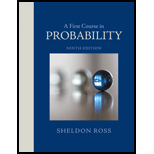
Concept explainers
From a set of n people, a committee of size j is to be chosen, and from this committee, a subcommittee of size
a. Derive a combinational identity by computing, in two ways, the number of possible choices of the committee and subcommittee—first by supposing that the committee is chosen first and then the subcommittee is chosen, and second by supposing that the subcommittee is chosen first and then the remaining members of the committee are chosen.
b. Use part (a) to prove the following combinatorial identity:
c. Use part (a) and Theoretical Exercise 13 to show that
Want to see the full answer?
Check out a sample textbook solution
Chapter 1 Solutions
A First Course in Probability
Additional Math Textbook Solutions
Precalculus: A Unit Circle Approach (3rd Edition)
Elementary Statistics Using The Ti-83/84 Plus Calculator, Books A La Carte Edition (5th Edition)
Introductory Statistics
College Algebra Essentials (5th Edition)
College Algebra (7th Edition)
Elementary Algebra For College Students (10th Edition)
- Please could you explain how to do integration by parts for this question in detail pleasearrow_forward2. Claim events on a portfolio of insurance policies follow a Poisson process with parameter A. Individual claim amounts follow a distribution X with density: f(x)=0.0122re001, g>0. The insurance company calculates premiums using a premium loading of 45%. (a) Derive the moment generating function Mx(t).arrow_forwardX GG G + C td.bksblive2.com.au/bksblive2/Play... E R New Chrome available CANVAS gmetrix N notion Six big immigratio... >>> All Bookmarks 1.1 ACSF L5 SC Geometry and Measure: Vectors Vectors State the vector quantities shown on the image below. AB = CD' = A B D < C 80 esc F1 F2 F3 F4 ? Help 7arrow_forward
- 2. Claim events on a portfolio of insurance policies follow a Poisson process with parameter A. Individual claim amounts follow a distribution X with density: f(x)=0.0122re001, g>0. The insurance company calculates premiums using a premium loading of 45%. (a) Derive the moment generating function Mx(t).arrow_forward2. Claim events on a portfolio of insurance policies follow a Poisson process with parameter A. Individual claim amounts follow a distribution X with density: f(x)=0.0122re001, g>0. The insurance company calculates premiums using a premium loading of 45%. (a) Derive the moment generating function Mx(t).arrow_forwardQ2 H let x(+) = &cos (Ait+U) and. 4(+) = ß cos(12t +V), where d. B. 1. In Constants and U,V indep.rus have uniform dist. (-π,π) Show that: ①Rxy (+,4+1)=0 @ Rxy (++) = cos [ when U=V Q3 let x(t) is stochastic process with Wss -121 e, and Rx ltst+1) = ( 2, show that E(X) = E(XS-X₁)² = 2(-1). Qu let x(t) = U Cost + (V+1) Sint, tεIR. where UV indep.rus, and let E (U)-E(V)=0 and E(U) = E(V) = 1, show that Cov (Xt, Xs) = K (t,s) = cos(s-t) X(+) is not WSS.arrow_forward
- Patterns in Floor Tiling A square floor is to be tiled with square tiles as shown. There are blue tiles on the main diagonals and red tiles everywhere else. In all cases, both blue and red tiles must be used. and the two diagonals must have a common blue tile at the center of the floor. If 81 blue tiles will be used, how many red tiles will be needed? For what numbers in place of 81 would this problem still be solvable? Find an expression in k giving the number of red tiles required in general.arrow_forwardAt a BBQ, you can choose to eat a burger, hotdog or pizza. you can choose to drink water, juice or pop. If you choose your meal at random, what is the probability that you will choose juice and a hot dog? What is the probability that you will not choose a burger and choose either water or pop?arrow_forwarda card is drawn from a standard deck of 52 cards. If a card is choosen at random, what is the probability that the card is a)heart b)a face card or c)a spade or 10arrow_forward
- in a coffee shop, 160 customers came in. Of these, 60 bought coffe and cake and the rest ordered just coffee. determine the probability that the next person will buy coffee and cakearrow_forwardTwo dice are rolled and their sum calculated. Draw a table to show all of the possibilities. Determine the theoretical probability of rolling a sum of 7. And determine the theoretical probability of rolling a sum greater than 9arrow_forwardA football player makes 350 out of every 400 passes he throws. In a game he usually throws 26 passes. Estimate how many of these passes will be successfularrow_forward
 Elements Of Modern AlgebraAlgebraISBN:9781285463230Author:Gilbert, Linda, JimmiePublisher:Cengage Learning,
Elements Of Modern AlgebraAlgebraISBN:9781285463230Author:Gilbert, Linda, JimmiePublisher:Cengage Learning, Linear Algebra: A Modern IntroductionAlgebraISBN:9781285463247Author:David PoolePublisher:Cengage Learning
Linear Algebra: A Modern IntroductionAlgebraISBN:9781285463247Author:David PoolePublisher:Cengage Learning Algebra: Structure And Method, Book 1AlgebraISBN:9780395977224Author:Richard G. Brown, Mary P. Dolciani, Robert H. Sorgenfrey, William L. ColePublisher:McDougal Littell
Algebra: Structure And Method, Book 1AlgebraISBN:9780395977224Author:Richard G. Brown, Mary P. Dolciani, Robert H. Sorgenfrey, William L. ColePublisher:McDougal Littell Elementary Geometry For College Students, 7eGeometryISBN:9781337614085Author:Alexander, Daniel C.; Koeberlein, Geralyn M.Publisher:Cengage,
Elementary Geometry For College Students, 7eGeometryISBN:9781337614085Author:Alexander, Daniel C.; Koeberlein, Geralyn M.Publisher:Cengage, Elementary Linear Algebra (MindTap Course List)AlgebraISBN:9781305658004Author:Ron LarsonPublisher:Cengage Learning
Elementary Linear Algebra (MindTap Course List)AlgebraISBN:9781305658004Author:Ron LarsonPublisher:Cengage Learning




